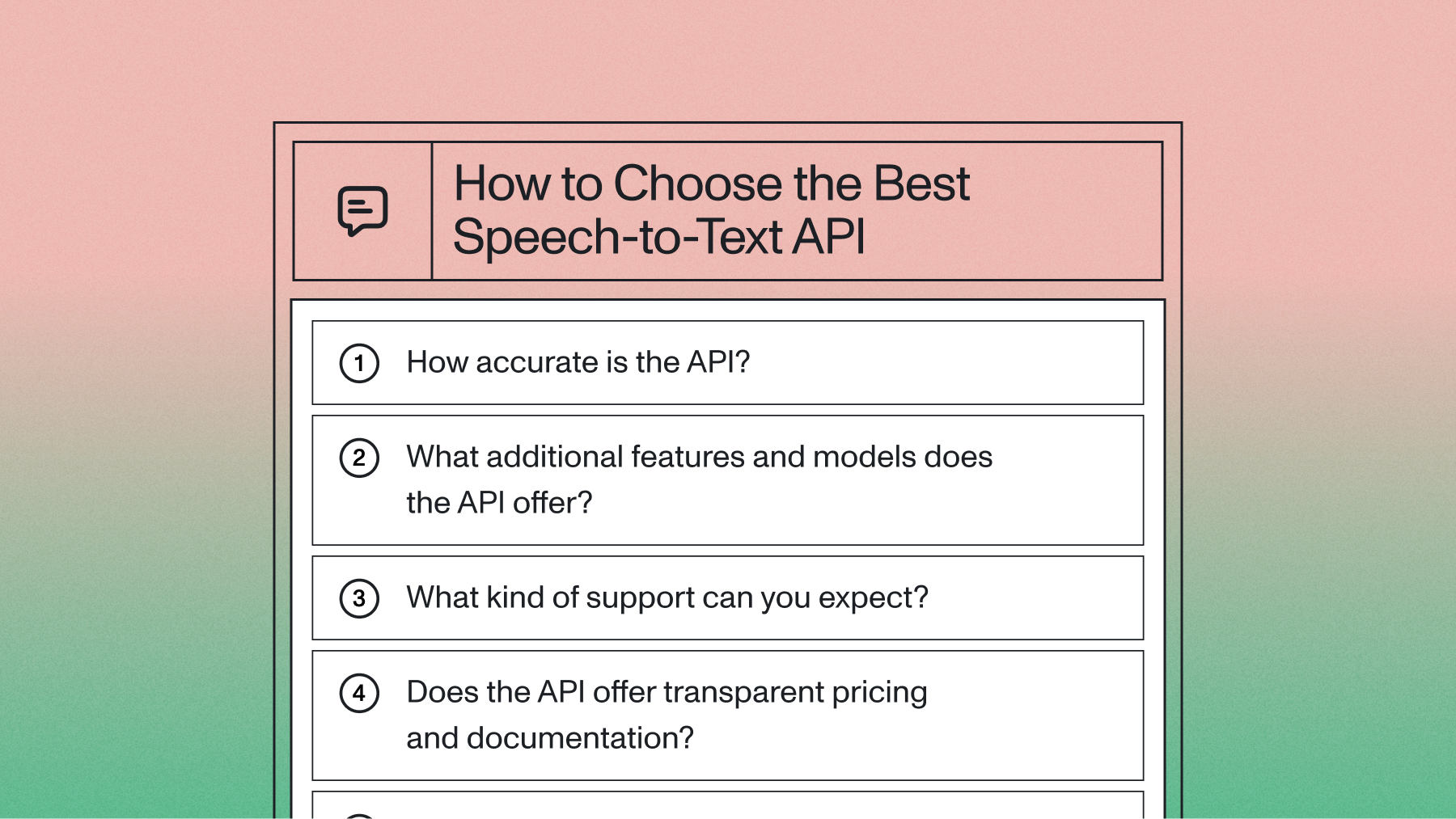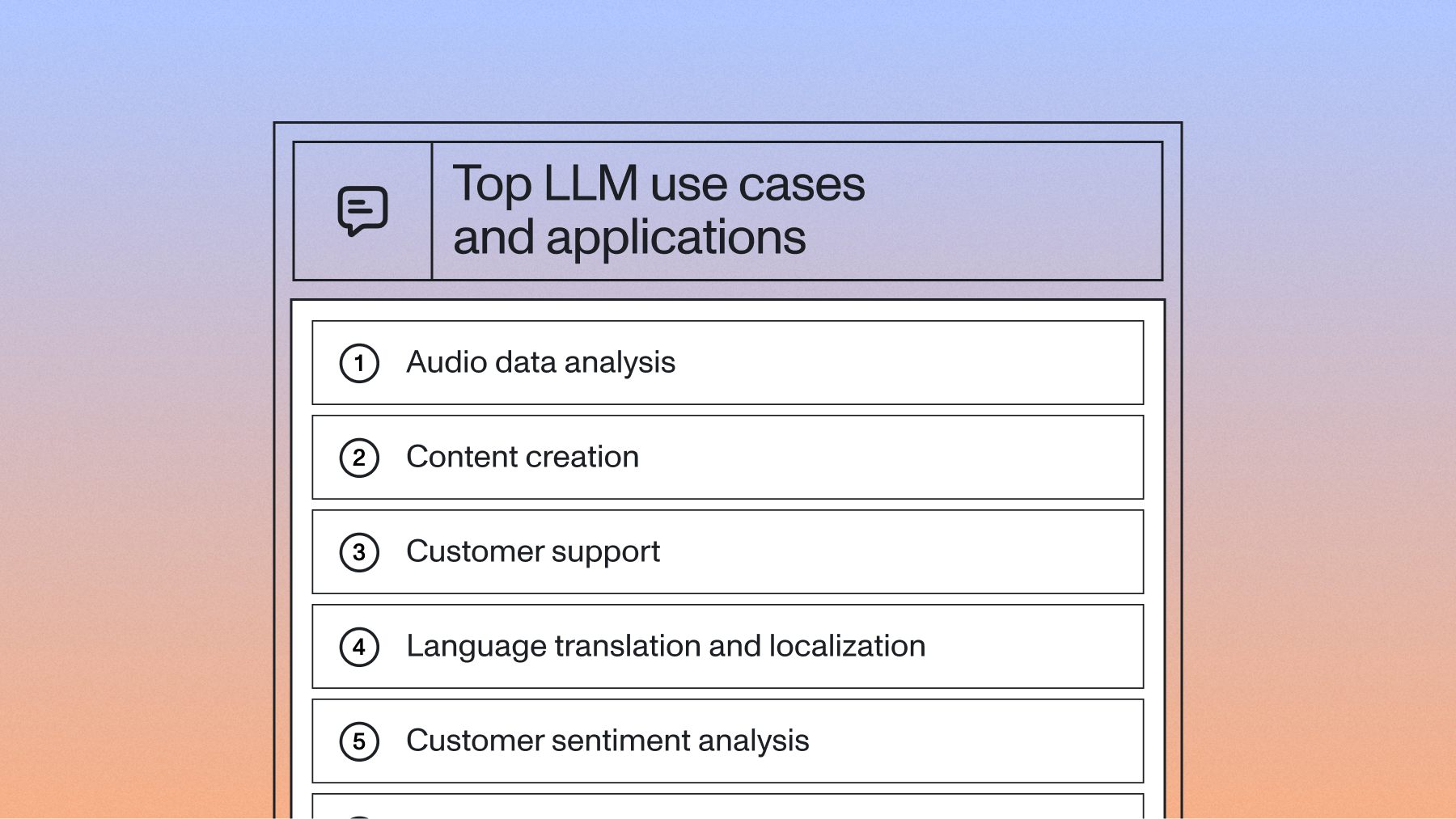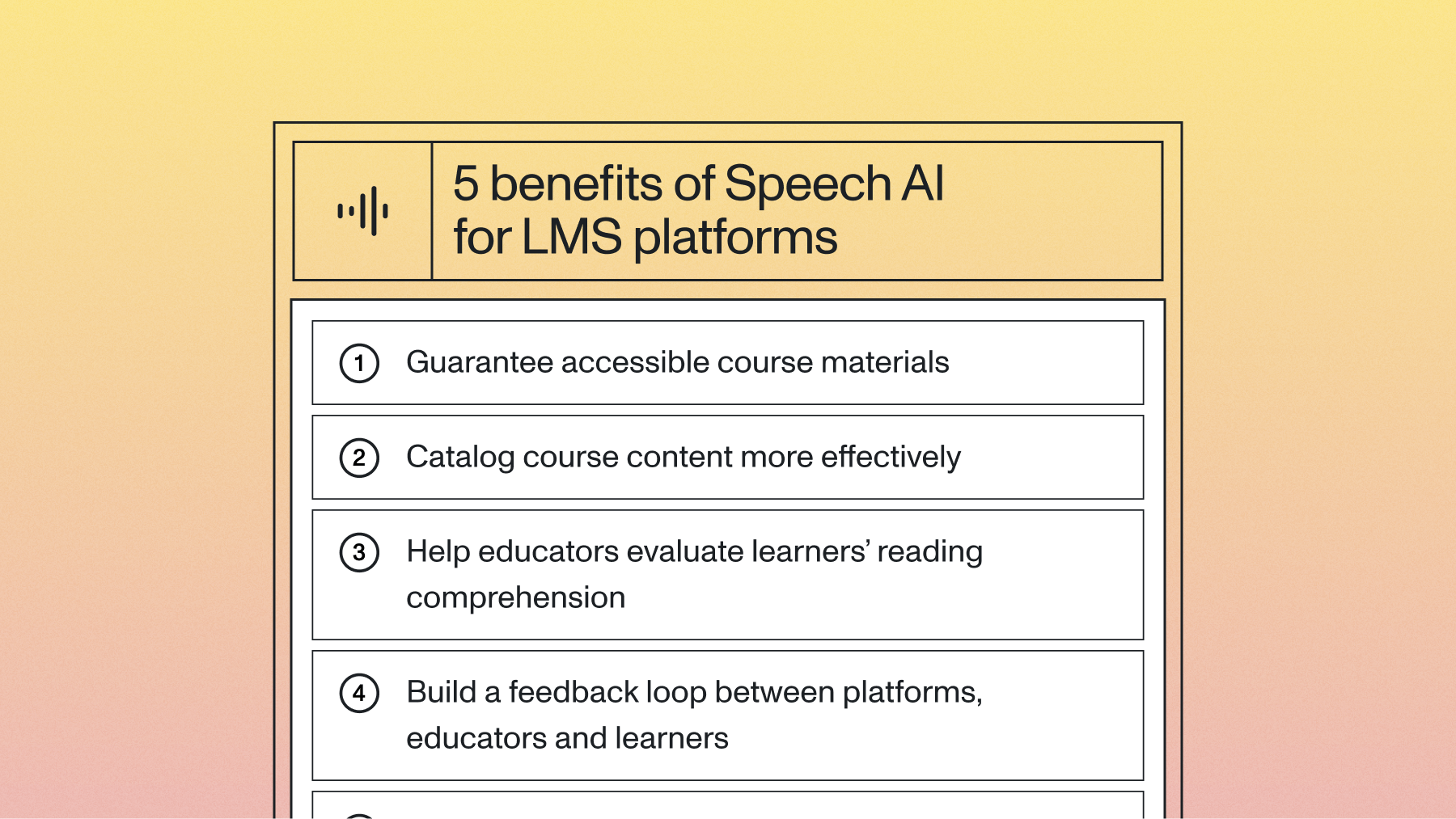Put Speech AI on the roadmap
Staying ahead means embracing the right tools at the right time, and Speech AI is transforming how companies interact with customers, process information, and make decisions.



Staying ahead means embracing the right tools at the right time, and Speech AI is transforming how companies interact with customers, process information, and make decisions.
You probably already use Speech AI technology every day without even realizing it. Voice assistants on your phone, live transcriptions on your TV show, or even a phone call with a bot to schedule an appointment—these are all examples of Speech AI in action.
However, its potential goes far beyond simple voice recognition. From summarizing meetings to analyzing customer responses in real-time, Speech AI is opening up new possibilities across practically every industry.
Customer experience is king and data-driven decisions are non-negotiable—and Speech AI offers a competitive advance that’s hard to ignore.
Here’s why Speech AI should be on your roadmap for 2025 (and beyond).
What is Speech AI?
Speech AI turns conversations into actionable data, and it does it primarily in three different areas. Together, these three components of Speech AI transform how businesses handle voice data:
1. Speech-to-text
Speech AI starts with converting spoken words into written text. Modern Speech-to-text (STT) technology has come a long way from the clunky voice recognition of the past.
Today's STT models can handle different accents, filter out background noise, and even differentiate between speakers in a conversation. Plus, it continues to get smarter and more accurate. The latest models boast accuracy rates of over 95%—that's better than some human transcribers.
2. Streaming Speech-to-text
Streaming Speech-to-text makes that same powerful STT technology work in real-time. This technology transcribes audio as it's happening with barely any delay. This opens up a world of possibilities—from live captioning for accessibility to real-time analytics in call centers.
3. Speech understanding
Speech understanding takes all that transcribed text and makes sense of it. It's not just about what was said, but what it means.
This technology can:
- Identify key topics in a conversation
- Extract important entities like names, places, or products
- Summarize long conversations into key points
It's like having a team of expert analysts listening to every conversation, picking out the important bits, and giving you the highlights.
Test out Speech AI in the no-code AI playground
What industries are building with Speech AI?
From boardrooms to doctor's offices, call centers to classrooms, businesses are finding innovative ways to put Speech AI to work. Here are a handful of industries pioneering the technology in new and exciting ways.
1. Conversation Intelligence
Conversational intelligence uses AI to extract valuable insights from voice interactions. It goes beyond just listening—it understands, analyzes, and provides actionable insights. Speech AI is the engine that drives these conversational intelligence platforms. Here’s how it works:
- Transcription: First, Speech-to-Text AI accurately transcribes conversations.
- Analysis: Then, Audio Intelligence models go to work. They can:
- Identify topics and key phrases
- Recognize entities (product names, competitor mentions)
- Summarize long conversations into digestible snippets
- Insight Generation: Large Language Models (LLMs) can also generate deeper insights, answer specific questions about the conversation, or even suggest follow-up actions.
For example, CallRail (a leading intelligence software company) uses conversation intelligence to auto-score and categorize key sections of calls. This leads to better lead tracking and improved relationship building for their customers.
2. Healthcare
Speech AI provides new ways for healthcare companies to collect, analyze, and interpret data to better support and understand the patient experience. Here's how:
- Turning conversations into searchable data: Speech AI converts audio from interviews, focus groups, and panel discussions into searchable text. This means researchers can quickly locate specific topics or quotes without manually sifting through hours of recordings.
- Organizing and categorizing for deeper insights: Researchers can tag and categorize audio segments based on topics or keywords to create an organized repository of information. This level of organization lets researchers track how certain themes evolve over time or compare discussions across multiple studies.
- Maintain data privacy: Speech AI provides models that offerPersonally Identifiable Information (PII) redaction features, allowing companies to minimize sensitive information about individuals by automatically identifying and removing it from their transcripts
3. Transcription Services
Speech AI can help transcribe everything from legal depositions to medical records, from media production to business meetings. However, this technology goes beyond what a human can do with a keyboard. Here’s a look at its potential:
- Accuracy and efficiency: Advanced models like Universal-1 (trained on a staggering 12.5M hours of multilingual audio data) can handle complex audio with nuances in speech, background noise, and even overlapping conversations.
- Scalability: Your transcription capacity is limited only by computing power, not human resources. Speech AI systems work 24/7 without fatigue while maintaining consistent quality (regardless of workload).
- Cost-effectiveness: Speech AI operates at a fraction of the cost of human transcription.
- Multilingual: Speech AI breaks down language barriers to provide support for a wide range of languages, accents, and dialects.
- Customization: Speech AI can be trained to understand and accurately transcribe specialized content like legal, medical, and technical jargon.
- Real-time: Real-time transcription helps with everything from live event captioning to instant meeting transcriptions.
- Accessibility: Speech AI democratizes information by providing accurate written versions of auditory content.
Companies are already taking advantage of these services:
- Screenloop (a hiring intelligence platform) achieved a 90% reduction in manual tasks and 20% faster hiring by integrating AI-powered transcription.
- Aloware (a Contact Center SaaS) offers smart transcription and quality assurance tools to save customers hours of call listening and opening up new insights.
- YouTube Transcripts generates one-click transcripts for videos to expand reach and accessibility for content creators.
4. Contact Centers
Contact centers are where customer loyalty is won and lost (usually in just minutes). Speech AI helps turn every call into an opportunity to improve:
- Better customer understanding: Speech AI dives deep into voice interactions to understand every conversation.
- Agent performance optimization: Speech AI delivers unbiased training to help your agents identify strengths and areas for improvement.
- Operational efficiency boost: Speech AI frees up valuable human resources by automating call monitoring and analysis.
- Sales opportunities uncovered: Every conversation holds potential sales opportunities, but they’re often hidden in subtle cues. Speech AI helps identify these moments and transform routine interactions into revenue-generating touchpoints.
- Manual work reduction: Post-call tasks can bog down agents and slow operations. Speech AI automates call logging, summarization, and action item extraction to help agents focus more on customers and less on paperwork.
- Employee support: Contact center work can be demanding. Speech AI can identify challenging callers and allow for appropriate routing and support.
5. Market Research
Market research platforms use Speech AI to better collect, analyze, and deliver customer insights. Here’s how it streamlines the entire process:
- Accurate transcription of voice and video surveys: Speech AI turns hours of audio and video feedback into searchable, analyzable text.
- Generation of key highlights and analysis: Speech AI can automatically generate summaries and detect key theme.
- Easy categorization, tagging, and searching of responses: Speech AI makes massive amounts of qualitative data easy to navigate.
6. Video Editing
Speech AI democratizes video editing and turns everyone into a potential content creator. Here’s how it helps with video management and edits:
- Automatic caption generation: Speech AI can automatically generate accurate captions.
- Better searchability and indexing: Finding the right clip in hours of footage is now as easy as searching for a word in a document. Speech AI makes video content as searchable as text.
- Smarter collaboration: Speech AI unlocks insights from video content to help your teams create data-driven content strategies.
7. Call Tracking
Phone calls are your business’s deepest wealth of insights, but they’re tedious and time-consuming to sift through on your own. Speech AI automates this process to better track leads and reveal actionable insights from your conversations:
- Improved lead intelligence: Speech AI-powered call tracking integrates with your other marketing data to provide a 360-degree view of each lead's journey (from first click to final call).
- Real-time insights and coaching: Speech AI can analyze calls as they happen to provide real-time guidance to sales reps and flag important moments for managers.
8. Revenue Intelligence
The right information at the right time makes the difference between closing a deal and losing it. With Speech AI, revenue intelligence doesn’t have to be a burdensome chore—it can be an automated strategic advantage:
- Automatic identification of special call moments: Speech AI can pinpoint important sections of calls—from key questions to objections raised—without manual intervention.
- Better digital selling and deal-specific insights: Speech AI generates actionable, deal-specific insights that helps your sales teams focus on winnable opportunities.
- Data-driven coaching and customer engagement: Speech AI provides relevant data insights that improve your sales team performance and keep customers engaged throughout the sales process.
9. Virtual Meetings
Virtual meetings can be more than one-off video calls. They can become a goldmine of actionable insights, and Speech AI can help makes these meetings even more productive and collaborative:
- Accurate meeting transcription: Now, your participants can actually pay attention and engage with the meeting while Speech AI automatically generates transcripts.
- Customized meeting summaries: No more scrolling through pages of notes. Speech AI can distill lengthy meetings into concise, actionable summaries.
- Automated action items and insights: Transform discussions into results. Speech AI can identify and extract action items and provide deeper insights from your meetings.
What are companies building with Speech AI?
Speech AI has come a long way and plenty of businesses are already leveraging this technology to create groundbreaking products and services. Here’s just a small sample of the most exciting applications:
- AI-powered classroom management (ClassDojo): ClassDojo built an online platform that uses AI to help teachers create story posts, perform evaluations, and communicate with families.
- Intelligent meeting assistants (Fireflies.ai): Fireflies.ai created an AI-powered voice assistant that automates note-taking and workflow management. Their new Fireflies Feed generates a comprehensive newsfeed of company activities—from key decisions to trending topics.
- Video content enhancement (Headliner): Headliner uses AI to help podcast and video creators improve their content. Their Eddy editing tool provides features to improve intros and outros, as well as AI-generated transcripts, episode art creation, and custom social media post generation.
- Sales performance optimization (Jiminny): Jiminny's conversation intelligence platform uses AI to help sales teams analyze their interactions with customers. Their tools have helped customers achieve a 15% higher win rate on average.
- Personalized TV streaming (Loop.tv): Loop Media integrated AI into their streaming platform to customize the viewing experiences to individual preferences.
- Developer productivity tools (Augment): Augment created an AI copilot for developers that has led to a 40% increase in overall productivity. The platform improves the coding experience by eliminating tedious tasks and helping developers focus on creative problem-solving.
- AI-powered meeting recording (Grain): Grain offers AI-powered meeting recording tools to help users better understand and advocate for their customers' needs. Their recent expansion to support Webex meetings (alongside Google Meet, Microsoft Teams, and Zoom) makes their intelligent insights accessible across all major virtual meeting platforms.
How to put Speech AI on your roadmap
Speech AI is transforming industries and applications, but how do you actually go about integrating this technology into your own business operations? Here’s a rough roadmap for adding Speech AI to your own roadmap:
- Evaluate your needs: See where Speech AI could add the most value to your business—whether it's improving customer service, streamlining transcription processes, or improving product offerings.
- Examine AI models: Compare different providers based on accuracy rates, processing speed, language support, and features like speaker diarization.
- Consider build vs. buy: Determine whether to develop capabilities in-house or partner with an AI provider.
- Address security and compliance: Double-check your chosen solution meets data privacy and security standards with features like end-to-end encryption and compliance with relevant regulations.
- Plan for integration: Consider how Speech AI will fit into your existing tech stack. You want solutions with clear API documentation and flexible integration.
- Budget for costs: Understand the pricing model of your chosen solution to see how per-use costs and expenses might scale as your usage grows.
Start small and scale: Consider beginning with a pilot project to test the technology's effectiveness for your use case and identify any integration challenges.
Lorem ipsum dolor sit amet, consectetur adipiscing elit, sed do eiusmod tempor incididunt ut labore et dolore magna aliqua. Ut enim ad minim veniam, quis nostrud exercitation ullamco laboris nisi ut aliquip ex ea commodo consequat. Duis aute irure dolor in reprehenderit in voluptate velit esse cillum dolore eu fugiat nulla pariatur.







